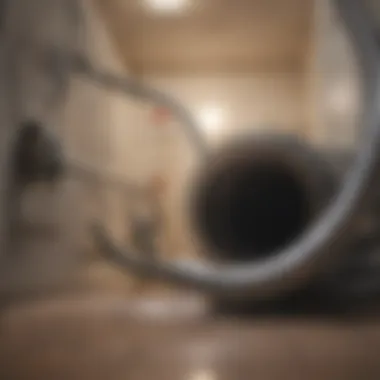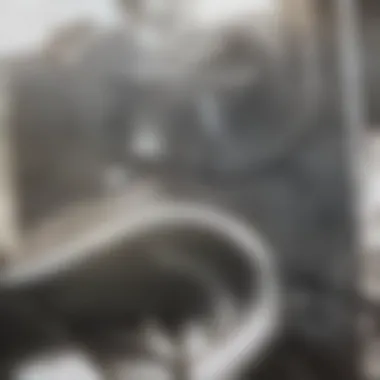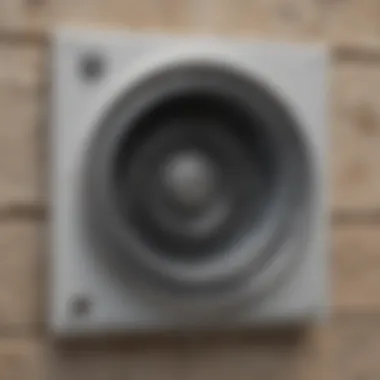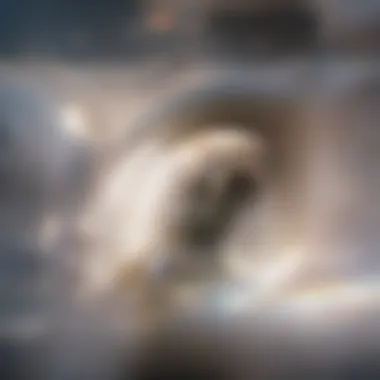Essential Steps for Replacing Your Dryer Vent Hose


Intro
Replacing your dryer vent hose is a crucial task that often gets overlooked by many homeowners. Proper ventilation is essential not just for the efficiency of your dryer, but also for the safety and health of your living environment. A clogged or damaged vent hose can lead to longer drying times, increased energy bills, and potential fire hazards. This guide will walk you through the process step by step, ensuring that you are equipped with the knowledge needed to tackle this home maintenance task with confidence.
In the following sections, we will explore the tools required, common challenges you may face, and best practices to keep your dryer in optimal working condition. By the end, you will have a comprehensive understanding of why and how to replace your dryer vent hose effectively, contributing to a safer and more efficient home.
Understanding the Importance of a Dryer Vent Hose
A dryer vent hose plays a crucial role in the efficient operation of your dryer. While it may seem like a minor component, its effectiveness greatly impacts both the overall performance of your appliance and the safety of your home. Understanding this importance is essential for any homeowner seeking to maintain a reliable and safe laundry environment.
Role in Dryer Efficiency
The dryer vent hose is responsible for directing hot, moist air from your dryer to the outside of your home. This process is critical for maintaining efficiency. If the vent hose becomes clogged or damaged, it restricts airflow, leading to longer drying times. This inefficiency can increaseenergy consumption, resulting in higher utility bills.
To illustrate this, studies show that a clean and properly functioning vent hose can reduce drying time by up to 50%. When clothes dry faster, the dryer uses less energy and prolongs its lifespan. Therefore, maintaining your vent hose is not just about convenience; it is also about sustainability and cost-effectiveness.
Significance for Home Safety
Beyond efficiency, the significance of a dryer vent hose extends into safety considerations. A blocked or improperly maintained vent can lead to a build-up of lint, which poses a serious fire risk. According to the National Fire Protection Association, failure to clean dryer vents is a leading cause of household fires, causing thousands of reported incidents each year.
Ensuring that your dryer vent hose is in good condition minimizes this risk. Regular inspections and timely replacements are critical steps in safeguarding your home and family. Home safety should always be a priority, and understanding the role of the vent hose is a vital part of that effort.
"A well-maintained dryer vent system not only improves performance but significantly reduces fire hazards in your home."
Recognizing When to Replace Your Dryer Vent Hose
Recognizing the need to replace your dryer vent hose is crucial for maintaining a functional and safe laundry environment. Over time, wear and tear can lead to inefficiencies or even hazards. A timely replacement can prevent costly repairs and improve appliance performance. Homeowners should be attentive to the signs that indicate a hose replacement is necessary. This awareness not only enhances the dryer’s efficiency but also safeguards the household from potential risks associated with poor venting.
Signs of Wear and Tear
There are several indicators that your dryer vent hose may be approaching the end of its usable life. Here are some common signs to look out for:
- Cracks or Splits: Visually inspect your hose for any visible damage. Cracks or splits can cause air leaks and reduce the efficiency of your dryer.
- Lint Buildup: Excessive lint accumulation around the hose or in the vent indicates that the air is not flowing freely. This condition can increase the risk of fire and should not be ignored.
- Pest Invasion: If you notice any signs of pests near your dryer vent, it may be time to replace the hose. Damaged hoses can provide entry points for rodents or insects.
- Abnormal Sounds: If your dryer makes unusual sounds during operation, this may be a sign that the vent hose is either kinked, obstructed, or failing.
Performance Degradation Indicators
Performance degradation can manifest in various forms. Here are some key indicators to monitor:
- Longer Drying Times: If laundry takes longer than usual to dry, it may signal that the vent hose is obstructed or damaged.
- Overheating: A dryer that frequently overheats can indicate insufficient airflow, often a result of a compromised vent hose.
- Increased Energy Bills: A noticeable rise in your energy costs can also be an indirect sign of a failing vent hose. Inefficient dryers use more energy to operate.
- Moisture Build-up: Any excessive moisture in the laundry area may suggest that the vent is not effectively expelling hot air, thus prompting the need for replacement.
Maintaining an efficient dryer vent system is not just about performance; it is about safety as well. Regular checks can prevent hazardous situations that arise from neglect.
Understanding these indicators allows homeowners to make informed decisions about their dryer maintenence. It is wise to be proactive rather than reactive when it comes to household appliances.
Essential Tools for Replacement
Replacing a dryer vent hose effectively requires not only knowledge but also the right tools. Using adequate tools enhances the safety of the process and ensures the efficiency of the new installation. Improper tools can lead to damage during disassembly or assembly, potentially making the task more difficult than it should be. This section emphasizes the essential tools needed for replacing your dryer vent hose.
Basic Hand Tools Required
When approaching this project, a few basic hand tools are necessary. These tools can often be found in any household or purchased at a local hardware store. Here are the key tools you will need:
- Screwdriver Set: A flathead and a Phillips screwdriver are crucial for loosening and tightening screws on vent clamps and connections.
- Pliers: Needle-nose pliers can help grip narrow areas and manipulate various fittings in tight spaces.
- Utility Knife: Useful for cutting old or damaged hose, this tool will make the task cleaner and more effective.
- Measuring Tape: To ensure you buy a new hose of the correct length, measuring the old hose can save time and prevent mistakes.
- Duct Tape: Although not a primary tool, duct tape can assist with temporary fixes and securing connections after installation.


Safety Equipment and Precautions
When replacing a dryer vent hose, safety should be a top priority. Homeowners often overlook safety measures during home repairs. Here are some essential safety equipment and precautions to consider:
- Safety Goggles: Protect your eyes when working with tools and materials that may create dust or debris.
- Dust Mask: A mask can help keep respiratory issues at bay when handling lint or dust during the replacement process.
- Gloves: Wearing gloves can protect your hands from sharp edges on the vent hose, and also from grease or grime that may accumulate on the hose.
Remember, taking safety measures not only protects you during the maneuver but also minimizes the risk of damage to your home's structure.
Tools play a critical role in the success of your dryer vent hose replacement. Being equipped with the right tools and following safety precautions paves the way for a smooth and effective replacement process.
Procurement of Suitable Dryer Vent Hose
When considering the replacement of a dryer vent hose, the procurement process is crucial. Selecting the right vent hose extends the lifespan and efficiency of the dryer while ensuring safe operation. An unsuitable or low-quality vent hose can lead to poor airflow and potential fire hazards due to lint accumulation. Therefore, it is important to consider both material and sizing when making your purchase.
Material Options Available
The material of the dryer vent hose has a significant impact on its performance and longevity. Various options are available in the market:
- Aluminum: Lightweight and able to resist high heat, aluminum is often considered the best choice for dryer vent hoses. Its durability enhances airflow and lessens fire risk.
- Flexible Vinyl: While easy to install due to its flexibility, vinyl is not recommended for long-term use. It can easily crush or become damaged, leading to blockages and inefficiency.
- Stainless Steel: This option provides excellent durability and resistance to fire. It offers superior strength, but it is more expensive than other materials.
- Semi-rigid Aluminum: This combines the advantages of both flexible and rigid hoses. It has sturdiness but can bend into various shapes, allowing for an easy fit in challenging spaces.
In summary, aluminum and stainless steel are generally recommended for new installations or replacements whenever possible.
Choosing the Right Diameter
Selecting the appropriate diameter for your dryer vent hose is equally important. A hose that is too narrow may restrict airflow, causing the dryer to work harder. Conversely, a hose that is too large can create inefficient airflow patterns, compromising performance.
Here are key points to consider:
- Common Sizes: Most dryer vent hoses come in diameters of 4 inches. This size fits most models of dryers in homes today.
- Manufacturer Recommendations: Always check the manufacturer's guidelines for the appropriate diameter for your specific dryer model. Manufacturers often specify the diameter needed to maintain efficiency.
- Airflow Efficiency: Ensuring the right diameter promotes better airflow. Lint is less likely to build up, reducing the risk of fires and keeping your dryer running smoothly.
In summary, a thorough understanding of both the material and diameter when procuring a dryer vent hose helps maintain the appliance efficiency and enhances safety in the home.
Preparation Before Replacement
Proper preparation is critical when replacing your dryer vent hose. Taking the time to ensure everything is set before you begin the process can save you from potential headaches and unsafe situations later. This section discusses the importance of preparation, highlighting key elements such as ensuring safety and locating critical components.
Powering Off the Dryer
Before starting any replacement work, turning off the dryer is essential. This action prevents any chance of accidental starts, which can be hazardous. Make sure to unplug the dryer from the wall outlet. If your dryer operates on gas, shut off the gas supply as well. Safety first is a good principle.
Also, check if the dryer has been used recently; if so, allow it to cool down before you handle it. This reduces the risk of burns or other injuries.
Locating Connection Points
Identifying where the dryer vent hose connects to both the dryer and the outlet is important. Closely inspect both ends of the dryer and the duct leading to the exterior of your home. Here are several steps to consider in this part of the process:
- Move the Dryer: Depending on the space, you might need to carefully pull the dryer out from its location to access the connections.
- Examine the Connections: The connections are usually secured with clamps or screws. Familiarize yourself with how they are configured so you can easily detach the old hose.
- Check for Obstructions: Ensure that any ductwork or covering does not obstruct your access or movement.
Locating and securing connection points quickens the replacement process. It offers clarity on the steps to take once you bring in the new hose.
"Preparation is the key to successful projects. Understand the steps beforehand to avoid complications."
By addressing these important preparatory tasks, you pave the way for a smoother and safer replacement of your dryer vent hose.


Step-by-Step Replacement Process
Replacing a dryer vent hose is critical for maintaining dryer efficiency and safety in your home. Following a systematic, step-by-step process ensures that the task is done correctly and efficiently. Neglecting any step may result in inadequate installation, which can lead to issues such as poor dryer performance or even fire hazards. Therefore, incorporating a thoughtful procedure is paramount to achieving satisfactory results in this project.
Removing the Old Vent Hose
To begin the replacement process, you need to safely detach the existing vent hose from the dryer. This step is vital as it clears the pathway for the new installation. Before proceeding, make sure you turn off the dryer and unplug it to avoid any electrical hazards. Look for the clamps or screw connectors that hold the old vent hose in place.
Gently loosen these fittings to avoid damage to the housing. If the old hose is stuck or shows signs of wear, such as being crushed or kinked, consider using a utility knife with caution to cut away portions if necessary. Once freed, remove the entire vent hose and inspect the connection points for any leftover debris or fragments, as these can impede the effectiveness of the new hose.
Installing the New Hose
Installation of the new vent hose is where careful attention is crucial. Ensuring the connections are secure and the hose is aligned properly can greatly enhance the overall performance of the dryer.
Securing Connections
Securing connections is a central aspect of a well-functioning vent system. This involves ensuring that the clamps or screws used to attach the hose are firmly tightened. A tight connection is critical to prevent unwanted air leaks, which can significantly reduce dryer efficiency. Often, adjustable clamps made of durable metal are recommended for their secure grip and longevity.
It's important to keep in mind that while a tight seal is desired, over-tightening can also create problems. This could lead to bending or rupturing of the hose, which may cause new leaks. Thus, the goal should be to achieve a snug fit without applying excessive pressure.
Ensuring Proper Alignment
Ensuring proper alignment is an equally important consideration. This means that the vent hose must lay flat and straight without any twists or turns. Misalignment can cause airflow blockages which can result in less efficient drying cycles and possible lint buildup, posing fire risks.
When installing the hose, ensure it is directed away from the dryer and leading smoothly to the outside vent. The ideal configuration allows for airflow to pass freely through the hose without any unnecessary bends. Proper alignment enhances the efficacy of the drying process, ultimately supporting the goal of maintaining a safe and efficient home appliance system.
Testing for Leaks and Blockages
After the installation, it's essential to test the new setup. Begin this process by re-connecting power to the dryer and running a short cycle. Observe the vent exterior for any signs of air leakage. Ensure that air flows freely without obstruction. You can use a simple method by placing a small piece of lightweight paper near the vent; if it moves, you have a good seal.
Additionally, consider using a flashlight to look inside the vent to detect any potential blockages. This precaution will confirm that everything is functioning appropriately and alleviate concerns for future dryer operations.
Addressing Common Challenges
When replacing your dryer vent hose, several challenges may arise. Being aware of these difficulties is crucial for a smooth and successful replacement process. Addressing common challenges not only ensures the longevity and efficiency of the dryer vent system but also enhances overall home safety. By understanding potential problems, such as stubborn fasteners and misalignment issues, homeowners can prepare and respond effectively.
Dealing with Stubborn Fasteners
Stubborn fasteners present a frequent obstacle during dryer vent hose replacement. Over time, metal screws or clamps can become rusted or stripped. This can make them difficult to remove. Using the wrong tools can also contribute to the frustration.
To tackle this problem:
- Use penetrating oil: A few sprays of penetrating oil can help loosen rusted fasteners. Apply it, then wait a few minutes before attempting removal.
- Select the right tools: Ensure to use proper screwdrivers or socket wrenches that perfectly fit the fastener heads. This reduces the chance of stripping them further.
- Leverage heat: If safe to do, applying heat to the area can expand the metal and help loosen stubborn screws for easier removal.
- Cut if necessary: If all else fails, using a pair of cutting pliers to cut through the fastener or a Dremel tool may be your last option.
Addressing stubborn fasteners in this manner not only helps in the immediate task but also fosters confidence for future repairs or replacements.
Overcoming Misalignment Issues
Misalignment during the dryer vent installation is another common challenge. It can cause various problems, including airflow restriction and increased risk of lint build-up. This issue can stem from improperly measured hose lengths or awkward angles from the dryer exhaust.
To effectively overcome alignment problems:
- Double-check measurements: Prior to installation, measure the required hose length carefully. Ensure that your calculations account for bends and turns.
- Choose adjustable connectors: Utilize flexible or adjustable connectors that allow for slight modifications in alignment. This can help you adapt the vent hose to the space available.
- Secure appropriately: Once in position, make sure the connections are tight but not overly strained. Use clamps to secure the vent hose at both the dryer and the wall.
- Inspect after installation: After replacing the hose, run the dryer for a short period and observe any unusual noises or airflow issues. Address any misalignment immediately.


By focusing on potential misalignment issues, homeowners can maintain a proper airflow, which is vital for both dryer efficiency and safety.
Best Practices for Maintenance
Maintaining the dryer vent hose is pivotal for ensuring the appliance functions properly. Adhering to best practices not only enhances dryer efficiency but also minimizes safety risks associated with clogged or damaged vent hoses. Ignoring maintenance can lead to increased energy bills, longer drying times, and potential fire hazards. This section delineates key practices for maintaining your dryer vent system, focusing on the necessity of regular inspections and cleaning.
Regular Inspection Guidelines
Regular inspections are critical. Homeowners should set a schedule to check their dryer vent hose and system. Here are key points to consider during an inspection:
- Check for physical damage: Look for cracks, tears, or any signs of wear on the hose. Even minor damages can result in significant performance issues.
- Inspect connections: Ensure that connections to the dryer and the external vent are secure and not leaking air.
- Evaluate airflow: While the dryer is operating, monitor the airflow. If airflow seems diminished, there may be a blockage.
It's helpful to document each inspection. This can create a maintenance history, making it easier to spot patterns indicating when repairs might be needed.
Cleaning the Vent System
Cleaning the vent system is equally important. A clean vent promotes efficient airflow and reduces fire risk. Homeowners should aim to clean the vent system at least once a year. Here’s a strategy to enhance cleaning efforts:
- Unplug the dryer: Always start by disconnecting the dryer from the power source to ensure safety.
- Remove the vent hose: Carefully detach the hose from both the dryer and the external vent.
- Use a brush: A vent cleaning brush can help remove lint and debris stuck inside the hose. This should be done gently to avoid damaging the tubing.
- Inspect the external vent: Ensure that the external vent is not blocked by debris or snow. A blocked external vent can significantly impair dryer performance.
- Reconnect everything: Once clean, securely attach the hose and check all connections.
Remember: Regular cleaning can prevent the buildup of lint, which is one of the leading causes of dryer fires. Establishing a maintenance routine will confer both safety and efficiency benefits, making every drying cycle a bit more reliable.
The Environmental Impact of Dryer Vent Maintenance
Maintaining your dryer vent is not solely about improving efficiency or ensuring safety; it also holds notable implications for the environment. Understanding these impacts enhances the conversation around dryer maintenance. By following eco-friendly practices, homeowners can contribute to energy conservation and pollution reduction.
Energy Efficiency Considerations
One of the most significant elements of dryer vent maintenance is energy efficiency. A clean and properly installed vent allows your dryer to operate effectively, minimizing energy consumption. Over time, lint buildup in the vent can lead to reduced airflow, forcing the dryer to work harder and increasing energy usage.
- Reduced Energy Bills: Properly maintaining your dryer vent can lead to significant savings on energy bills. An efficient dryer consumes less power, which is beneficial for the household budget.
- Extended Appliance Life: When the dryer operates more efficiently, it can also extend the lifespan of the appliance. Less strain on the machine minimizes wear and tear, reducing the need for premature replacements.
Addressing energy efficiency is not merely a matter of convenience; it's a call to action to subject matter experts, real estate enthusiasts, and sustainability advocates to enhance practices that promote lower energy consumption in their households.
Reducing Air Pollution Risks
Air quality is another critical aspect influenced by dryer vent maintenance. Poorly maintained vents can cause increased emissions and pollution, contributing to environmental health hazards. If the vent is clogged, moisture and pollutants can be released into your home and the outdoors.
- Indoor Air Quality: Regularly cleaning and servicing your dryer vent decreases the risk of indoor air pollutants. These include lint, mold, and mildew, which can adversely affect health, particularly among sensitive populations.
- Outdoor Emissions: When the dryer vent is working inefficiently, it may not expel air properly, leading to higher emissions. This can adversely affect neighborhoods and community ecosystems.
Performing routine maintenance on your dryer vent is a crucial step in fostering a healthier living environment and contributing to broader environmental sustainability efforts.
Ending
In any comprehensive guide, the conclusion serves a pivotal purpose. It synthesizes the information presented, reinforcing the primary points that have been covered while delineating their significance. In this article, the focus was on the replacement of dryer vent hoses, a topic often overlooked until problems arise.
Final Thoughts on Vent Hose Replacement
Replacing your dryer vent hose plays a crucial role in maintaining dryer efficiency and ensuring safety in your home. A well-functioning vent system helps the dryer operate effectively, reducing energy consumption and preventing overheating. Neglecting this component can result in reduced performance, potential fire hazards, and diminished air quality. Hence, becoming familiar with the process of replacement is invaluable for homeowners.
It's important to remember that selecting a quality hose and ensuring proper installation are essential steps. Regular checks can help detect any signs of wear or blockage before they escalate into significant issues.
"Taking proactive measures to replace your dryer vent hose not only enhances appliance efficiency but also safeguards your home."
Encouragement for Sustained Dryer Maintenance
Routine maintenance of your dryer vent system should not be an afterthought. Engaging in periodic inspections and cleanings can augment the lifespan of your appliances and maintain a safe environment in your residence. The time spent on these tasks can save you from costly repairs or replacements in the long run.
Utilizing specific touchpoints, such as:
- Regular cleaning: Remove lint and debris which can accumulate inside the vent.
- Checking connections: Ensure that all connections between the dryer and the vent are secure to prevent air leaks.
- Monitoring performance: Pay close attention to any changes in drying times or unusual noises that could indicate underlying issues.
Such practices ensure that your dryer remains reliable and efficient, ultimately benefiting both your household budget and the environment. Sustained maintenance translates to a better functioning system and less strain on energy resources. This is imperative in today's climate-conscious world where energy efficiency ranks high in importance.







